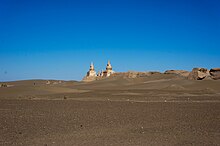Chara-Choto
Chara-Choto (also Karakhoto , Khara-Khoto ; Mongol. Khar Khot, Chin.黑 城 Heicheng, literally "Black City", probably identical with Marco Polos Eçina ) is a medieval Tangut city in the Ejin banner of the Alxa League in the west of inner Mongolia , near the old Juyan lake . Its ruins were discovered by the Russian explorer Pyotr Kozlov on his research trip to the Gobi Desert in the years 1901–1909.
history
In the 11th century the city was a flourishing Tangut trading center. The walled fortress was captured by Genghis Khan's troops in 1227 and - contrary to a widespread misunderstanding - the city continued to prosper under Mongol rule. In 1372 the Mongolian king Khara Bator and his subordinates were surrounded by the army of the rising Ming dynasty . The Chinese derived the water from the Heihe River ("Black River"), which flowed outside the fortress and supplied water to the city's gardens and fountains. Over time, Khara Bator realized his fate, killed his family and judged himself. After his suicide, his soldiers waited in the fortress until the Ming Chinese finally attacked and killed the remaining residents.
exploration
When it was rediscovered in modern times , Koslow's team found over 2,000 books in Tangut language , including the famous bilingual Tangut-Chinese glossary ( Fanhan heshi zhangzhongzhu 番 汉 合时 掌中 珠 ) by the Tangut scholar Gule (骨 勒) from 1190 There are still remnants of a ten meter high city wall and an outer wall over half a meter thick.
In Chinese archeology , the site is known as Heicheng yizhi (黑 城 遺址) or Alashan Heicheng yizhi (阿拉善 黑 城 遗址).
literature
- Pyotr Koslow: Mongolia, Amdo and the dead city of Chara-Choto. The expedition of the Russian Geographical Society 1907-1909. With an appendix, 4 maps and 129 pictures. Authorized translation from Russian by L. Breitfuß and Paul Gerhard Zeidler. With a foreword by Sven Hedin . Published by Wilhelm Filchner . Berlin, Neufeld & Henius, 1925
- Pyotr Kuzmich Kozlov, Mongolia, Amdo and the Dead City of Khara-Khoto , 1923
- Mikhail Pjotrowskij (Ed.): The black city on the Silk Road. Buddhist art from Khara Khoto (10th – 13th centuries). Thyssen-Bornemisza Foundation, Electa, Milan 1993
- Herbert Franke : "The Chinese finds from Chara-choto". In: Orientalistische Literaturzeitung 81 (1986), pp. 117–129
- Wu Daohong 吴道弘, Wang Jianhui 王建辉 and Zhang Lisheng 张立 升 (Eds.): Fanhan heshi zhangzhongzhu 番 汉 合时 掌中 珠. Hubei jiaoyu chubanshe 湖北 教育 出版社 2004 (Zhongguo chuban shiliao · Gudai bufen 中国 出版 史料 · 古代 部分)
- Never Hongyin and Shi Jinbo: Fanhan heshi zhangzhongzhu 番 汉 合时 掌中 珠. Yinchuan 1989.
Web links
- Images from Khara Khoto
- Alxa, the first national desert geology park in China
- Nie Hongyin (CASS): Tangutology During the Past Decades ( Memento from February 26, 2012 in the Internet Archive )
Individual evidence
- ↑ Р.К. Kozlov's Mongolia and Sichuan Expedition (1907-1909): the Discovery of Khara-Khoto
- ↑ Donavan Webster: Alashan - Into the Heart of the Gobi Desert. National Geographic Germany, 2002 ( Memento of the original from March 4, 2016 in the Internet Archive ) Info: The archive link was inserted automatically and has not yet been checked. Please check the original and archive link according to the instructions and then remove this notice.
Coordinates: 41 ° 45 '48 " N , 101 ° 8' 37.1" E


